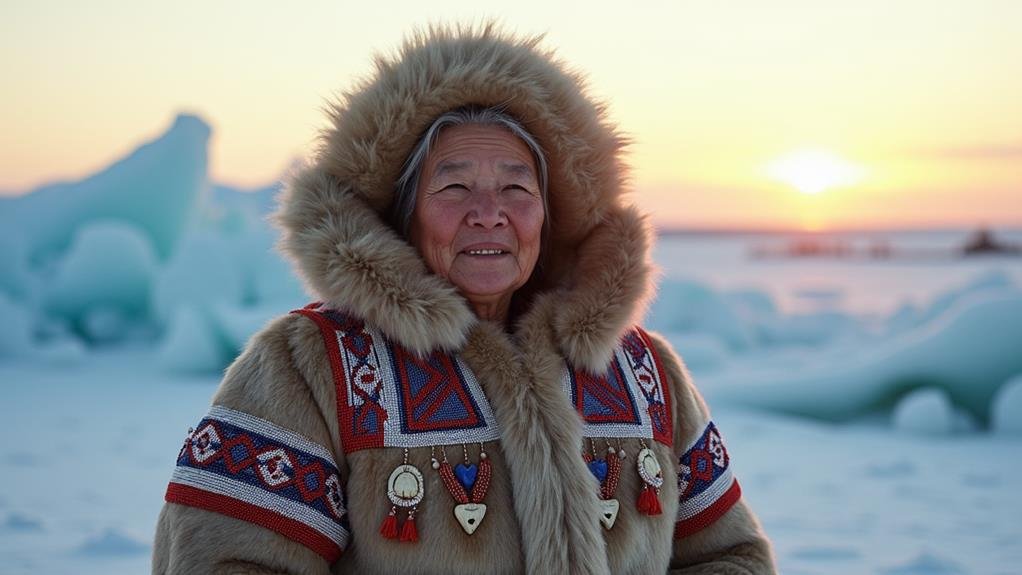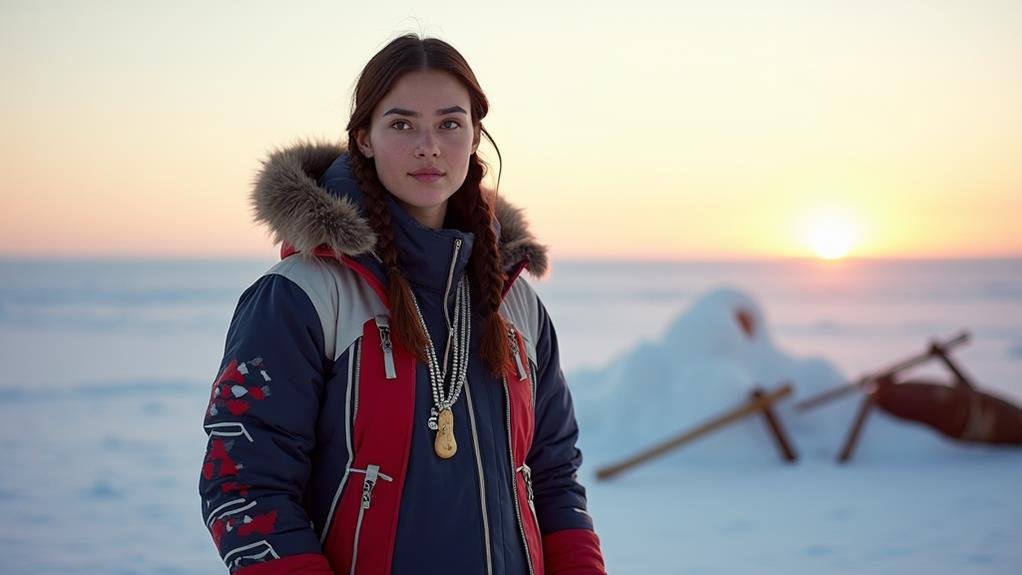The Inuit's mastery of Arctic survival hasn't just shaped their clothing—it's revolutionized how humanity thinks about cold-weather gear. Their traditional garments represent an intricate blend of necessity and artistry, where every stitch and pattern serves both practical and cultural purposes. From the innovative design of the amauti, which allows mothers to carry infants while maintaining mobility, to the waterproof sealskin boots that have inspired modern winter footwear, these adaptations showcase an unmatched understanding of extreme climate survival. Yet beneath these practical considerations lies a deeper story of cultural identity and resilience that continues to influence contemporary fashion.
Main Points
- Inuit clothing utilizes a sophisticated two-layer system with animal hides, primarily caribou and sealskin, for optimal Arctic insulation.
- Traditional garments like the amauti and qarliik combine practicality with cultural significance through distinct regional designs.
- Kamiit (mukluks) feature multiple fur layers and specialized construction techniques for maximum foot protection in extreme cold.
- Clothing designs incorporate cultural identifiers indicating community affiliation, age, and marital status through specific patterns and features.
- Modern adaptations blend traditional materials with synthetic components while preserving ancestral techniques and cultural significance.
Materials and Construction Techniques
Nearly all traditional Inuit clothing relies on animal hides, particularly caribou and sealskin, which provide exceptional insulation in the harsh Arctic climate. The construction of these garments follows a sophisticated two-layer system, where the inner layer's fur faces inward to trap body heat, while the outer layer's fur faces outward to create an additional insulating barrier.
Inuit women, who traditionally handle the crafting of clothing, use specialized tools in their work. The ulu, a curved knife, enables precise cutting of skins, while awls facilitate the intricate stitching required for durable garments. For sewing, they utilize sinew from caribou backstraps as thread, ensuring the clothing remains flexible and strong under extreme conditions.
The preparation of skins demands meticulous attention to detail. Before construction begins, the skins undergo careful processing through specific dampening, scraping, and drying techniques. This careful treatment prevents brittleness and maintains the material's integrity, ensuring the finished clothing can withstand the demanding Arctic environment. These traditional methods of preparing and constructing garments have been refined over generations, producing clothing that's perfectly adapted to Arctic survival.
Traditional Garment Styles
While each Inuit region developed distinct clothing variations, several core garment styles remain fundamental across Arctic communities. Traditional clothing includes the akuitoq, a men's outer parka designed with a loose fit to facilitate hunting movements, and the amauti, a women's garment featuring a specialized pouch for carrying infants. These designs showcase how Inuit groups adapted their clothing to meet both practical needs and cultural customs.
Qarliik, the traditional trousers used by both men and women, played a significant role in Arctic survival. Men often wore two layers, with the inner layer providing essential warmth during extended hunting expeditions. Caribou skin is used extensively in these garments, offering superior insulation and durability. The kamiit, or mukluks, serve as the foundation of this clothing system, featuring multiple fur layers for ideal foot protection and mobility.
Modern Inuit communities continue to recognize these garment styles as important cultural markers. Specific design elements in the outer parka indicate the wearer's community affiliation, age, and marital status, preserving traditional social customs while meeting the demanding requirements of Arctic life.
Cultural Significance Through Design

Inuit clothing stands out as a powerful expression of cultural identity, with intricate designs and patterns woven into every garment telling stories of community belonging, social status, and family lineage. Traditional skin clothing serves as a visual language, with distinctive features indicating the wearer's age, marital status, and kin group affiliations through carefully crafted elements.
The amauti exemplifies this cultural significance, as it's not merely a practical garment for harsh environmental conditions but also represents the profound connection between mothers and infants in Inuit cultures. The clothing production process itself carries deep spiritual and cultural meaning, with techniques and designs passed down through generations as sacred knowledge.
Contemporary Inuit fashion continues to honor these traditions while embracing modern materials and methods. Today's designers blend ancestral patterns with new techniques, ensuring the preservation of cultural identity through evolving styles. This adaptation demonstrates the resilience of Inuit craftsmanship, as artisans maintain the symbolic importance of traditional designs while creating garments that resonate with modern wearers, proving that cultural expression through clothing remains a essential aspect of Inuit identity.
Arctic Survival Functionality
Three critical layers of engineering make traditional Inuit clothing an unparalleled survival system in the Arctic's harsh conditions. The ingenious design starts with an inner layer of caribou skin, where fur faces inward to trap warm air against the body. The outer layer, often made from sea mammal or additional caribou skin, features fur pointing outward to create insulating air pockets that shield against extreme temperatures.
Traditional Inuit clothing is well-suited for constant movement and survival tasks. The amauti, a specialized single piece worn by women, demonstrates this functionality by allowing mothers to carry infants securely while maintaining mobility and warmth. The sophisticated design of skin garments extends to footwear, where kamiit can incorporate up to five distinct layers, providing essential flexibility and insulation for walking on ice and snow.
This time-tested clothing system reflects generations of refined craftsmanship, with each piece meticulously constructed to serve specific survival purposes. The effectiveness of traditional Inuit design principles has proven so successful that modern cold-weather gear continues to draw inspiration from these age-old techniques.
Modern Adaptations and Revival

A remarkable revival of traditional Inuit garment-making has emerged since the 1990s, blending ancestral techniques with contemporary innovations. Inuit organizations have taken the lead in preserving and modernizing their clothing heritage, ensuring that traditional craftsmanship remains pertinent in today's world. This resurgence reflects a broader movement within Indigenous American fashion, emphasizing both cultural identity and practical adaptation.
Modern Inuit clothing demonstrates skillful integration of synthetic materials alongside traditional animal skins, creating garments that honor cultural significance while meeting contemporary needs. These adaptations are particularly evident in hybrid designs, such as boots featuring skin tops combined with rubber bottoms, which provide enhanced functionality for urban environments. The evolution of these garments shows how Inuit communities have successfully balanced preservation with innovation.
Traditional skin clothing continues to play a crucial role in winter activities and ceremonial occasions, though modern design elements have been thoughtfully incorporated. This fusion approach has strengthened the connection between past and present, ensuring that Inuit clothing traditions remain dynamic and pertinent while maintaining their essential cultural character.
How Do Inuit Dwellings and Clothing Work Together to Ensure Survival in the Arctic?
In the freezing Arctic, survival depends on both clothing and shelter. Traditional Inuit clothing, made from animal skins and fur, provides insulation against sub-zero temperatures. At the same time, arctic inuit housing, such as igloos and sod houses, traps heat and protects against cold winds, ensuring a safe and warm environment.
Conclusion
Inuit clothing and adornment stand the test of time, blending ancestral wisdom with contemporary innovation. From traditional sealskin parkas to modern adaptations, these garments continue to weather the storm in both practical and cultural contexts. Today's artisans honor their heritage while embracing new materials and techniques, ensuring that Inuit fashion remains an essential expression of identity and a tribute to Arctic ingenuity.


